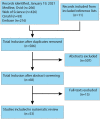Clinical characteristics of visual motion hypersensitivity: a systematic review
- PMID: 37341755
- PMCID: PMC10349011
- DOI: 10.1007/s00221-023-06652-3
Clinical characteristics of visual motion hypersensitivity: a systematic review
Abstract
This qualitative systematic review presents an overview of the state of the research relating to visual motion hypersensitivity (VMH) and offers a reference tool for future studies in the field. The study set out to identify and collate articles investigating risk groups with aberrant responses to visual motion as compared to healthy control groups, presenting evidence for risk factors associated with visual motion hypersensitivity. Data were synthesized into the state of the research and analyzed in the context of the clinical characteristics of each risk factor. Literature searches were performed on Medline Ovid, EMBASE, Web of Science, and Cinahl, identifying a total of 586 studies of which 54 were finally included. Original articles published between the dates of commencement for each database and 19th January 2021 were included. JBI critical appraisal tools were implemented for each corresponding article type. In total, the following number of studies was identified for each respective risk factor: age (n = 6), migraines (n = 8), concussions (n = 8), vestibular disorders (n = 13), psychiatric conditions (n = 5), and Parkinson's disease (n = 5). Several studies described VMH as the primary concern (n = 6), though these primarily included patients with vestibulopathies. There were considerable differences in the nomenclature employed to describe VMH, depending largely on the investigating group. An overview of investigated risk factors and their evaluation methods was presented in a Sankey diagram. Posturography was the most implemented methodology but due to diverse measurements meta-analyses were not possible. One may however note that while the easily implemented Vestibular Ocular Motor Screening (VOMS) was designed for concussed patients, it may prove useful for other risk groups.
Keywords: Dizziness; Motion sickness; Non-vestibular vertigo; Vertigo; Visual vertigo; Visually induced dizziness.
© 2023. The Author(s).
Conflict of interest statement
On behalf of all authors, the corresponding author states that there is no conflict of interest.
Figures
Similar articles
-
Interventions for eye movement disorders due to acquired brain injury.Cochrane Database Syst Rev. 2018 Mar 5;3(3):CD011290. doi: 10.1002/14651858.CD011290.pub2. Cochrane Database Syst Rev. 2018. PMID: 29505103 Free PMC article.
-
Health professionals' experience of teamwork education in acute hospital settings: a systematic review of qualitative literature.JBI Database System Rev Implement Rep. 2016 Apr;14(4):96-137. doi: 10.11124/JBISRIR-2016-1843. JBI Database System Rev Implement Rep. 2016. PMID: 27532314
-
What is the value of routinely testing full blood count, electrolytes and urea, and pulmonary function tests before elective surgery in patients with no apparent clinical indication and in subgroups of patients with common comorbidities: a systematic review of the clinical and cost-effective literature.Health Technol Assess. 2012 Dec;16(50):i-xvi, 1-159. doi: 10.3310/hta16500. Health Technol Assess. 2012. PMID: 23302507 Free PMC article.
-
Home treatment for mental health problems: a systematic review.Health Technol Assess. 2001;5(15):1-139. doi: 10.3310/hta5150. Health Technol Assess. 2001. PMID: 11532236
-
Systemic pharmacological treatments for chronic plaque psoriasis: a network meta-analysis.Cochrane Database Syst Rev. 2021 Apr 19;4(4):CD011535. doi: 10.1002/14651858.CD011535.pub4. Cochrane Database Syst Rev. 2021. Update in: Cochrane Database Syst Rev. 2022 May 23;5:CD011535. doi: 10.1002/14651858.CD011535.pub5. PMID: 33871055 Free PMC article. Updated.
Cited by
-
Investigating cortical activity during cybersickness by fNIRS.Sci Rep. 2024 Apr 6;14(1):8093. doi: 10.1038/s41598-024-58715-2. Sci Rep. 2024. PMID: 38582769 Free PMC article.
-
Arsenic Exposure and Neuropsychological Outcomes in Children: A Scoping Review.Toxics. 2025 Jun 28;13(7):542. doi: 10.3390/toxics13070542. Toxics. 2025. PMID: 40710988 Free PMC article. Review.
-
A Proposed Mechanism for Visual Vertigo: Post-Concussion Patients Have Higher Gain From Visual Input Into Subcortical Gaze Stabilization.Invest Ophthalmol Vis Sci. 2024 Apr 1;65(4):26. doi: 10.1167/iovs.65.4.26. Invest Ophthalmol Vis Sci. 2024. PMID: 38607620 Free PMC article.
-
Visual motion hypersensitivity, from spaceflight to Parkinson's disease-as the chiasmatic cistern may be impacted by microgravity together with normal terrestrial gravity-opposition physiology in the brain.Exp Brain Res. 2024 Mar;242(3):521-523. doi: 10.1007/s00221-024-06780-4. Epub 2024 Jan 22. Exp Brain Res. 2024. PMID: 38252144 No abstract available.
References
Publication types
MeSH terms
LinkOut - more resources
Full Text Sources
Medical



